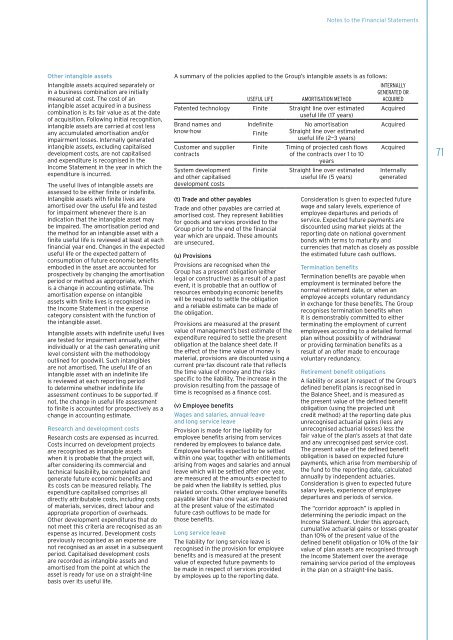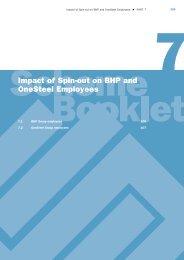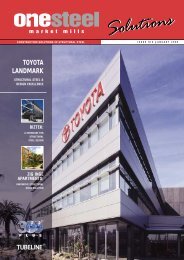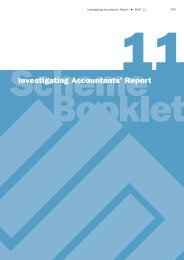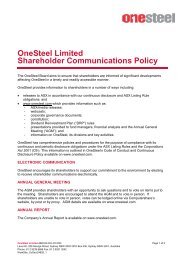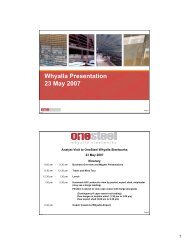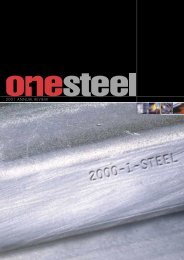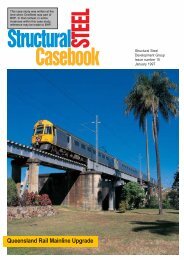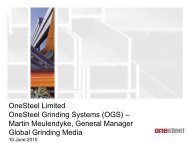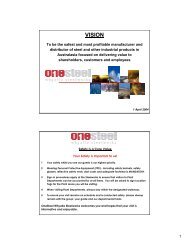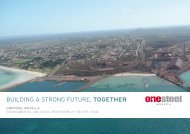BROADENING OUR HORIZONS - Arrium
BROADENING OUR HORIZONS - Arrium
BROADENING OUR HORIZONS - Arrium
- No tags were found...
Create successful ePaper yourself
Turn your PDF publications into a flip-book with our unique Google optimized e-Paper software.
Notes to the Financial StatementsOther intangible assetsIntangible assets acquired separately orin a business combination are initiallymeasured at cost. The cost of anintangible asset acquired in a businesscombination is its fair value as at the dateof acquisition. Following initial recognition,intangible assets are carried at cost lessany accumulated amortisation and/orimpairment losses. Internally generatedintangible assets, excluding capitaliseddevelopment costs, are not capitalisedand expenditure is recognised in theIncome Statement in the year in which theexpenditure is incurred.The useful lives of intangible assets areassessed to be either finite or indefinite.Intangible assets with finite lives areamortised over the useful life and testedfor impairment whenever there is anindication that the intangible asset maybe impaired. The amortisation period andthe method for an intangible asset with afinite useful life is reviewed at least at eachfinancial year end. Changes in the expecteduseful life or the expected pattern ofconsumption of future economic benefitsembodied in the asset are accounted forprospectively by changing the amortisationperiod or method as appropriate, whichis a change in accounting estimate. Theamortisation expense on intangibleassets with finite lives is recognised inthe Income Statement in the expensecategory consistent with the function ofthe intangible asset.Intangible assets with indefinite useful livesare tested for impairment annually, eitherindividually or at the cash generating unitlevel consistent with the methodologyoutlined for goodwill. Such intangiblesare not amortised. The useful life of anintangible asset with an indefinite lifeis reviewed at each reporting periodto determine whether indefinite lifeassessment continues to be supported. Ifnot, the change in useful life assessmentto finite is accounted for prospectively as achange in accounting estimate.Research and development costsResearch costs are expensed as incurred.Costs incurred on development projectsare recognised as intangible assetswhen it is probable that the project will,after considering its commercial andtechnical feasibility, be completed andgenerate future economic benefits andits costs can be measured reliably. Theexpenditure capitalised comprises alldirectly attributable costs, including costsof materials, services, direct labour andappropriate proportion of overheads.Other development expenditures that donot meet this criteria are recognised as anexpense as incurred. Development costspreviously recognised as an expense arenot recognised as an asset in a subsequentperiod. Capitalised development costsare recorded as intangible assets andamortised from the point at which theasset is ready for use on a straight-linebasis over its useful life.A summary of the policies applied to the Group’s intangible assets is as follows:Internallygenerated orUseful lifeAmortisation methodacquiredPatented technology Finite Straight line over estimated Acquireduseful life (17 years)Brand names and IndefiniteNo amortisationAcquiredknow-howFinite Straight line over estimateduseful life (2—3 years)Customer and suppliercontractsFinite Timing of projected cash flowsof the contracts over 1 to 10yearsAcquiredSystem developmentand other capitaliseddevelopment costsFinite(t) Trade and other payablesTrade and other payables are carried atamortised cost. They represent liabilitiesfor goods and services provided to theGroup prior to the end of the financialyear which are unpaid. These amountsare unsecured.(u) ProvisionsProvisions are recognised when theGroup has a present obligation (eitherlegal or constructive) as a result of a pastevent, it is probable that an outflow ofresources embodying economic benefitswill be required to settle the obligationand a reliable estimate can be made ofthe obligation.Provisions are measured at the presentvalue of management’s best estimate of theexpenditure required to settle the presentobligation at the balance sheet date. Ifthe effect of the time value of money ismaterial, provisions are discounted using acurrent pre-tax discount rate that reflectsthe time value of money and the risksspecific to the liability. The increase in theprovision resulting from the passage oftime is recognised as a finance cost.(v) Employee benefitsWages and salaries, annual leaveand long service leaveProvision is made for the liability foremployee benefits arising from servicesrendered by employees to balance date.Employee benefits expected to be settledwithin one year, together with entitlementsarising from wages and salaries and annualleave which will be settled after one year,are measured at the amounts expected tobe paid when the liability is settled, plusrelated on-costs. Other employee benefitspayable later than one year, are measuredat the present value of the estimatedfuture cash outflows to be made forthose benefits.Long service leaveThe liability for long service leave isrecognised in the provision for employeebenefits and is measured at the presentvalue of expected future payments tobe made in respect of services providedby employees up to the reporting date.Straight line over estimateduseful life (5 years)InternallygeneratedConsideration is given to expected futurewage and salary levels, experience ofemployee departures and periods ofservice. Expected future payments arediscounted using market yields at thereporting date on national governmentbonds with terms to maturity andcurrencies that match as closely as possiblethe estimated future cash outflows.Termination benefitsTermination benefits are payable whenemployment is terminated before thenormal retirement date, or when anemployee accepts voluntary redundancyin exchange for these benefits. The Grouprecognises termination benefits whenit is demonstrably committed to eitherterminating the employment of currentemployees according to a detailed formalplan without possibility of withdrawalor providing termination benefits as aresult of an offer made to encouragevoluntary redundancy.Retirement benefit obligationsA liability or asset in respect of the Group’sdefined benefit plans is recognised inthe Balance Sheet, and is measured asthe present value of the defined benefitobligation (using the projected unitcredit method) at the reporting date plusunrecognised actuarial gains (less anyunrecognised actuarial losses) less thefair value of the plan’s assets at that dateand any unrecognised past service cost.The present value of the defined benefitobligation is based on expected futurepayments, which arise from membership ofthe fund to the reporting date, calculatedannually by independent actuaries.Consideration is given to expected futuresalary levels, experience of employeedepartures and periods of service.The “corridor approach” is applied indetermining the periodic impact on theIncome Statement. Under this approach,cumulative actuarial gains or losses greaterthan 10% of the present value of thedefined benefit obligation or 10% of the fairvalue of plan assets are recognised throughthe Income Statement over the averageremaining service period of the employeesin the plan on a straight-line basis.71


